 Leisure and Cultural Services Department - Community Sports Club BulletinLeisure and Cultural Services Department
Leisure and Cultural Services Department - Community Sports Club BulletinLeisure and Cultural Services Department
Sports Recommendation
Canoeing
The origin and development of Canoes
Originated in the Stone Age, canoes may be said to be one of the oldest means of transport on water. In ancient times, humans hollowed out tree trunks to made small boats and used branches to paddle them. They were used for fishing, transport, and even warfare. Ancient canoes have been found all over the world, in places that include North America, Africa, the UK, the Middle East and China.
Canoes were widely popular and later developed into a sport. The world's first canoeing organisation was established in the UK in 1866. Since then the sport was developed all over the world. Canoe associations have been set up to promote the sport and organise competitions. In 1924, the International Canoeing Federation was founded. In the same year, as a demonstration sport, canoeing made its debut at the Paris Olympic Games. The men's and women's canoe sprint races became an official Olympic sport at the Berlin Olympic Games in 1936 and the London Olympic Games in 1948, respectively. Slalom canoeing was held for the first time at the 1972 Munich Olympic Games. Today, canoeing has become a main event of the Olympic Games.
Types of canoes and competitions
There are various types of canoe. Different types of canoe are used for different purposes. In general, the sport can be divided into kayaking and Canoeing. As far as design is concerned, a kayak has a covered deck while a canoe only has an open deck. Both types of canoe are equipped with seats. A kayak paddler uses a paddle with two blades while a canoe paddler uses a paddle with a single blade.
There are two disciplines of canoeing in the Olympic Games: sprint and slalom. In a sprint, kayaks with 1, 2 or 4 athletes or canoes with 1 or 2 athletes are used. An event is designated by the type of boat and the number of athletes in each boat, so we have K1, K2, K4, C1 and C2, where K stands for “kayak” and C stands for “canoe”.
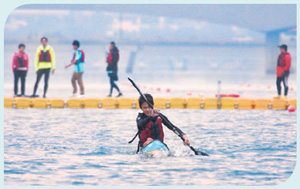 |
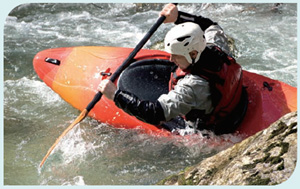 |
| Sprint K-1 | Slalom Kayak |
Equipment for Canoeing
| Kayak | Paddle | Lifejacket |
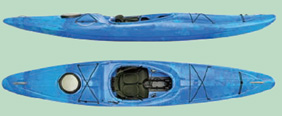 |
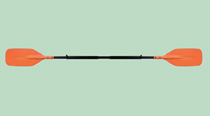 |
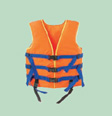 |
While athletes in a kayak sprint paddles sitting down, athletes in a canoe sprint often paddle kneeling on one knee. In a slalom, kayaks and canoes are also used. The usual slalom events are K1, C1 or C2, where the meanings of the letters and the numbers are the same as in sprints. A difference between a slalom and a sprint is that in a slalom canoe, an athlete is kneeling on both knees instead of one knee.
Athletes in a sprint wins if they finish the race the fastest. The course of a sprint is located on a river or sea. The distances are 200 metres, 500 metres and 1000 metres. There are groups of 1, 2 or 4 athletes. The course of a slalom is on river rapids. Athletes need to go through a number of gates during the race. A gate consists of two poles. There are downstream gates and upstream gates. Athletes need to pass through a downstream gate in the downstream direction and an upstream gate in the upstream direction. If the athletes touch the pole of a gate or fail to pass through a gate, there will be time penalties.
In addition to speed racing, canoeing has other forms of competition, for example canoe marathon, which requires high physical fitness, and canoe polo, which requires teamwork. Here are a few common forms of canoeing in Hong Kong:
•Canoe Marathon
Canoe marathon is long distance canoeing. It is usually divided into age groups. The course is about 18 to 23 km long, while courses of international competitions may be up to 30 or 40 km long, which are extremely challenging. If geographical or other factors make it impossible to have a course of a suitable length, then the course goes around a short course a number of times. Canoe marathon requires athletes to have explosive sprinting strength. It also tests their ability of making turns. Some marathon courses goes through rivers, lakes, rapids, bays and the sea, which test athletes' ability to canoe on calm water and rapid currents. The most highly regarded canoe marathon is the ICF World Canoe Marathon.
•Canoe Polo
As the name suggests, canoe polo is a combination of canoeing and water polo. It is played by two teams of five players. The players control the canoe and try to score goals. The team with more goals wins. Canoe polo is challenging and exciting. Athletes need good canoeing skills and a sensitive touch for offence and defence.
•Kayak Course Race
In kayak course race, athletes need to pass all checkpoints to reach the finishing point. The course is from 1000 m to 5000 m long, depending on factors such as the age of the athletes or the environmental restrictions. Since the race is not carried on fixed channels, athletes must have a good sense of distance, be skilful and devise a strategy to pass the checkpoints in the best route.
The development and promotion of canoeing in Hong Kong
Hong Kong's canoeing sport began in the 1950s, when it was introduced by British troops. Early canoes were made of materials such as wood and canvas. In the sixties, they were made of fibreglass, which is lighter. The Hong Kong Canoe Union was established in 1975. Subsequently it became a member of the Sports Federation & Olympic Committee of Hong Kong, China, the International Canoe Federation and the Asian Canoe Confederation.
There are many canoe elite athletes in Hong Kong. The have represented Hong Kong in international competitions such as the Olympic Games, World Championships, the Asian Games and the National Games of the People's Republic of China. They have won prizes in various international and intercity competitions.
Kayaking Courses offered by Water Sports Centres of the LCSD
Kayaking is a sport for all ages. Its equipment is simple. It is a popular outdoor sport. The Water Sports Centres of the LCSD provide different types of canoe for rent. They offer different kayaking certificate training courses, which last from one to three days and include training courses for young people which provide basic knowledge and practice opportunities to children from 8 to 13 years old. Many community canoe clubs also provide courses that are suitable for people all ages. Participants can enjoy paddling under guidance from coaches.
To take a kayaking course, visit the website of the LCSD:
http://www.lcsd.gov.hk/en/watersport/activities/acti_train/acti_trai_kaya/acti_trai_kaya_course.html
